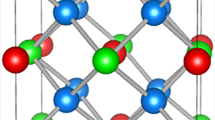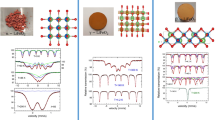Abstract
In the course of scientific development, occasionally a phenomenon is encountered which challenges our understanding and defies a complete explanation. Such a phenomenon occurs in the formation of Li5B4 compound-alloy which is formed by heating (not cooling). The liquid metallic solution of Li and B which exists at low temperature (300 to 450°C) transforms to a metallic solid at high temperature (500 to 550°C). Following the transformation to solid, Li5B4 compound-alloy formation takes place at 550 ± 2°C, accompanied by a heat release of about 2.2 ± 0.3 kcal per gram of B. The compound-alloy thus formed is a totally metallic solid existing from room temperature to 1000°C. Above 1000°C, the compound-alloy sublimes (with Li vaporizing) leaving behind a blackish substance. While these observations are unusual in terms of the wide composition and temperature ranges in which they occur, they are by no means ‘strange’. They are not inconsistent with the thermodynamic principles of phase diagrams and can be interpreted once the whole process is fully characterized.
Similar content being viewed by others
References
M. Hansen and K. Anderko: “Constitution of Binary Alloys,” McGraw-Hill Book Co., 1968; R. P. Elliott: “Constitution of Binary Alloys, 1st Supplement,” McGraw-Hill Book Co., 1965; F. A. Shunk: “Constitution of Binary Alloys, 2nd Supplement,” McGraw-Hill Book Co., 1969; “Handbook of Binary Metallic Systems,” Translated from Russian by J. Schmorak, 1966, U.S. Department of Commerce, 1966.
J. Casanova: French Patent 1,461,878, 1965.
L. W. Rupp and D. J. Hodges:J. Phys. Chem. Solids, 1974, vol. 35, pp. 617–19.
D. R. Secrist:J. Am. Ceram. Soc., 1967, vol. 50, pp. 520–23.
P. H. Schmidt: Private communication, Bell Telephone Laboratory, Murray Hill, New Jersey, 1974.
D. V. Keller, F. A. Kanda, and A. J. King:J. Phys. Chem., 1958, vol. 62, pp. 732–33.
R. G. Hirst, A. J. King, and F. A. Kanda:J. Phys. Chem., 1956, vol. 60, pp. 302–04.
D. R. Secrist and W. J. Childs: U.S. AEC TID-17149,1962.
Excepting the 550 C exothermic reaction, the temperature range indicated herein are only approximated and can vary by as much as ±15°C depending on the composition as well as the heating and cooling rate.
F. E. Wang, M. A. Mitchell, R. A. Sutula, J. R. Holden, and L. H. Bennett:J. Less-Common Metals, 1978, vol. 61, pp. 237–51.
M. A. Mitchell and R. A. Sutula:J. Less-Common Metals, 1978, vol. 57, pp. 161–75.
J. C. Schottmiller, A. J. King, and F. A. Kanda:J. Phys. Chem., 1958, vol. 62, pp. 1446–49.
A. W. Laubengayer, D. T. Hurd, A. E. Newkirk, and J. L. Hoard:J. Am. Chem. Soc., 1943, vol. 65, pp. 1924–31.
J. L. Hoard and A. E. Newkirk:J. Am. Chem. Soc., 1960, vol. 82, pp. 70–76.
N. V. Sidgwick:The Chemical Elements and Their Compounds, vol. I, Clarendon Press, Oxford, 1950.
C. T. Heycock and F. H. Neville:Philos. Trans. R. Soc. London, 1897, vol. A189, pp. 67–72; E.I. Petrenko:Z. Anorg. Chem., 1906, vol. 50, pp. 136–41.
K. Friedrich:Metallurgie, 1906, vol. 3, pp. 396–99; G. I. Petrenko:Z. Anorg. Chem., 1907, vol. 53, pp. 201–07; F. Yoldi and D. L. de A. Himinez:Anales. Soc. Espan. Fis. Equim., 1930, vol. 28, pp. 1055–65.
F. E. Wang, F. A. Kanda, and A. J. King:J. Phys. Chem., 1962, vol. 66, pp. 2138–42.
S. D. James and L. E. Devries:J. Electrochem. Soc, 1976, vol. 123, pp. 321–27.
F. E. Wang, M. A. Mitchell, and R. A. Sutula: Naval Surface Weapons Center, TR 77-84, 1977.
J. Less-Common Metals, 1976, vol. 47.
W. N. Lipscomb:Boron Hydrides, W. A. Benjamin, Inc., 1963.
J. R. Letelier, Y. N. Chiu, and F. E. Wang:Molecular and Electronic Structure of Li5B4, presented at the 6th International Symposium on Boron and Borides, Bulgaria, October 9–12, 1978.
J. J. Kaufman and L. M. Sachs:J. Chem. Phys., 1970, vol. 52, pp. 645–48.
Author information
Authors and Affiliations
Rights and permissions
About this article
Cite this article
Wang, F.E. An unusual phenomenon in the formation of Li5B4 compound-alloy. Metall Trans A 10, 343–348 (1979). https://doi.org/10.1007/BF02658343
Received:
Issue Date:
DOI: https://doi.org/10.1007/BF02658343




